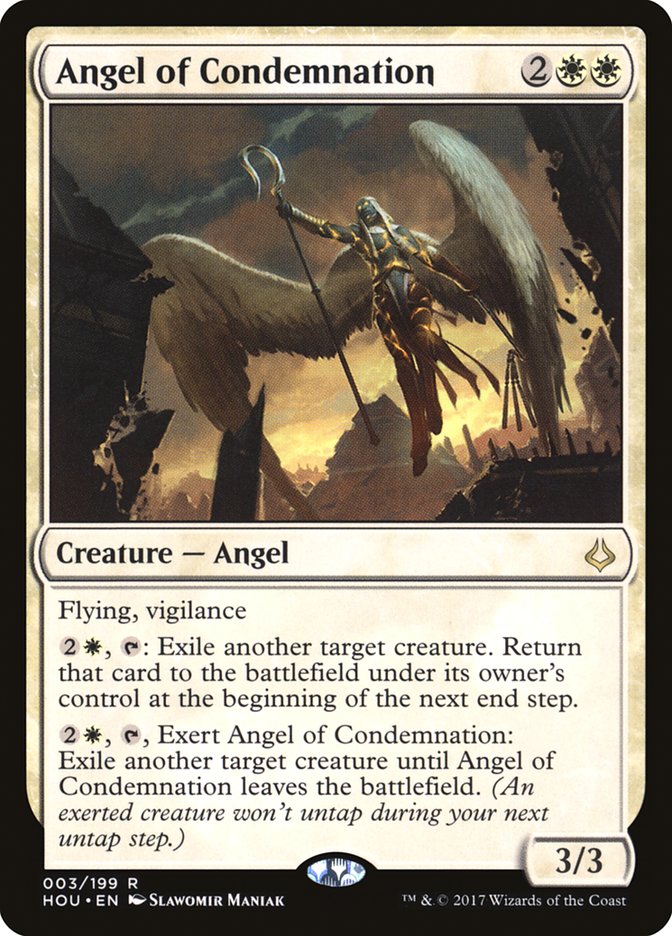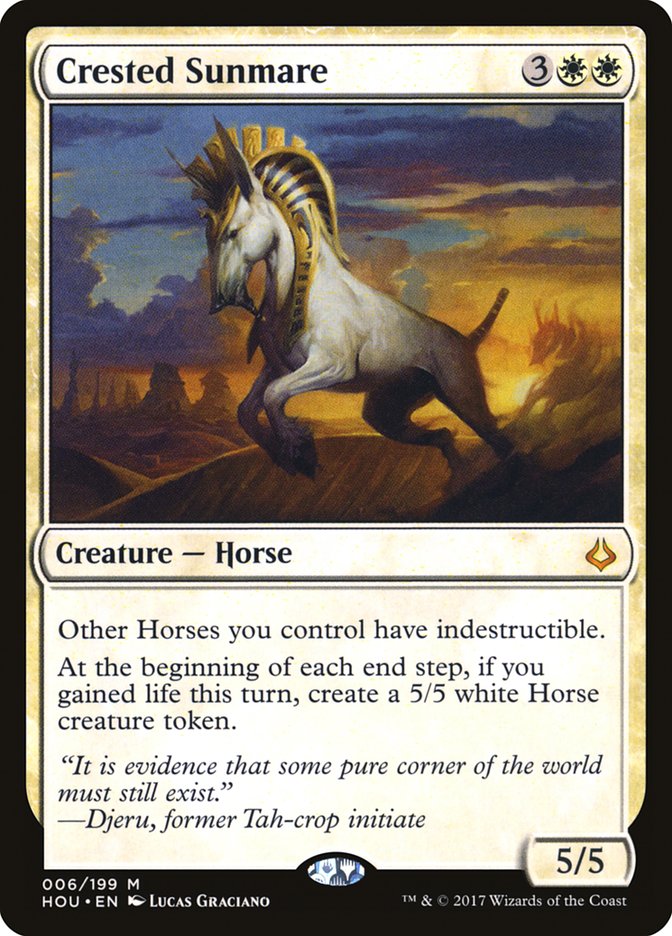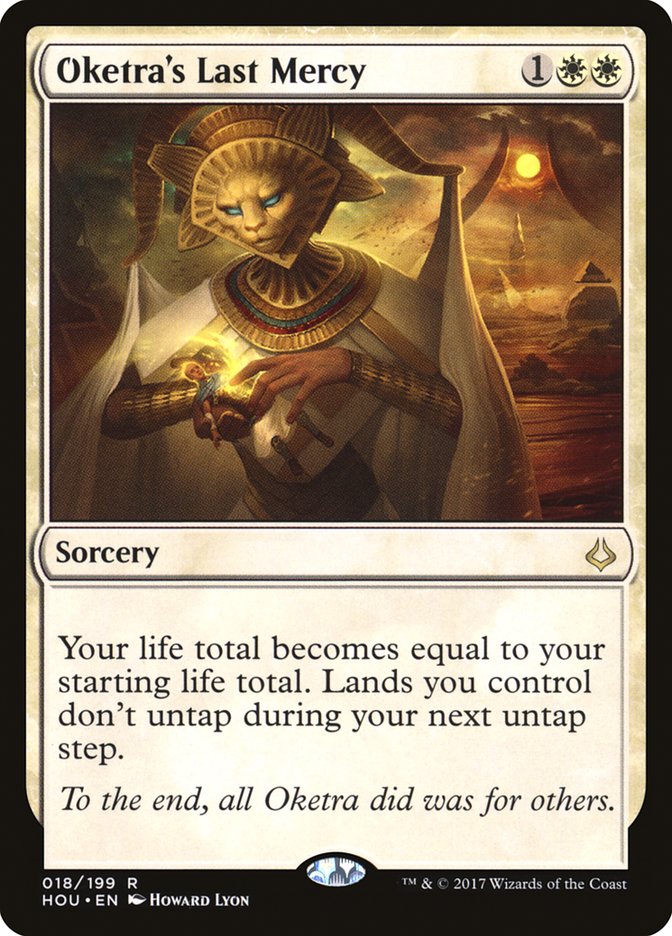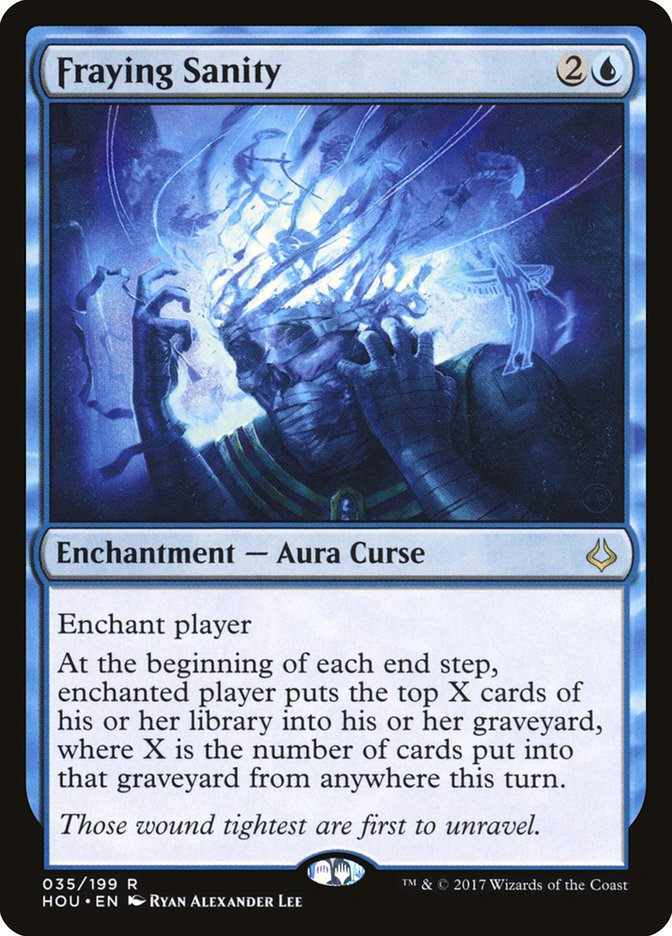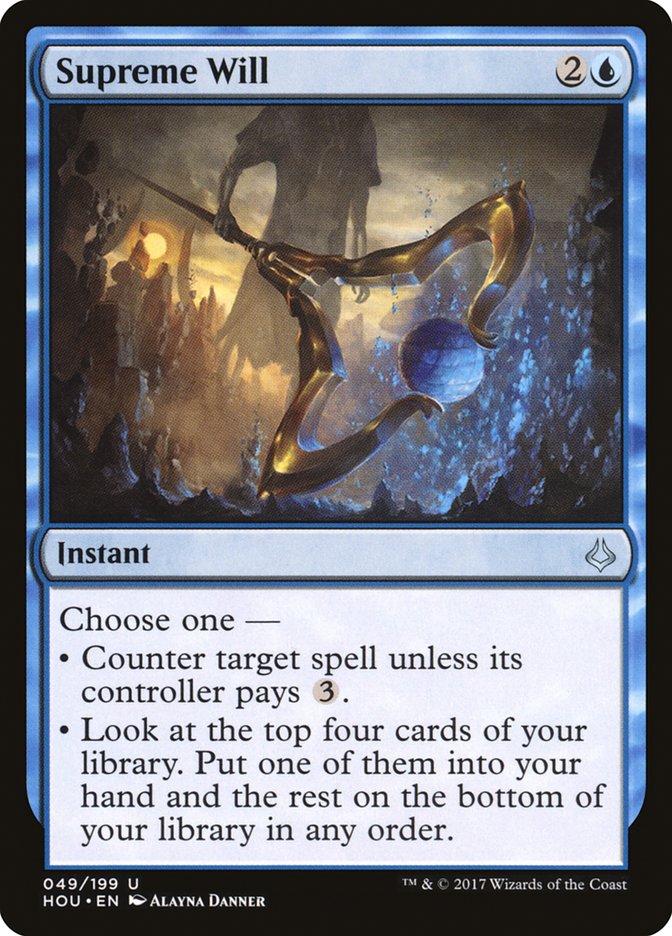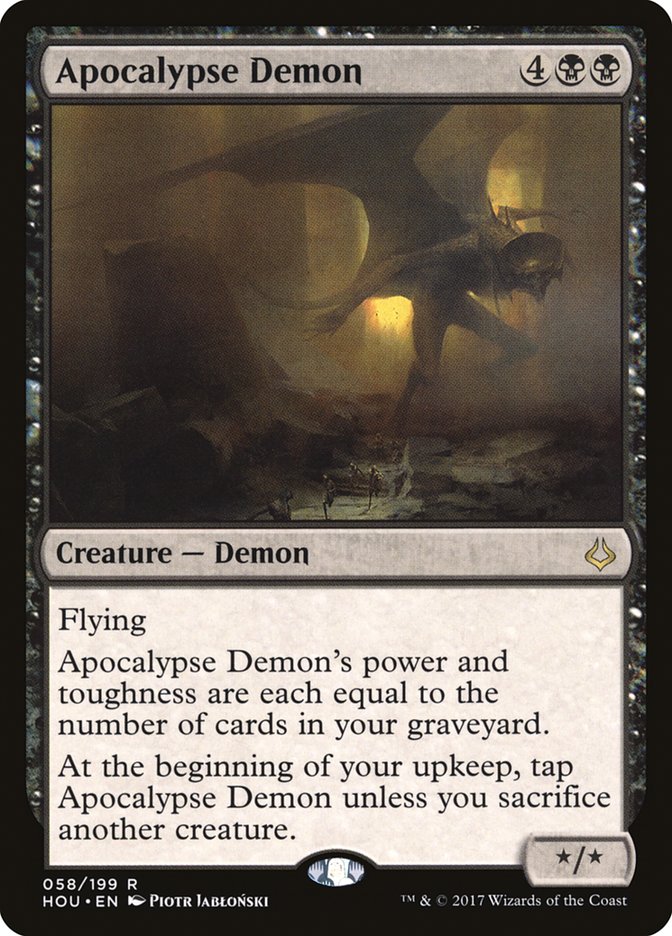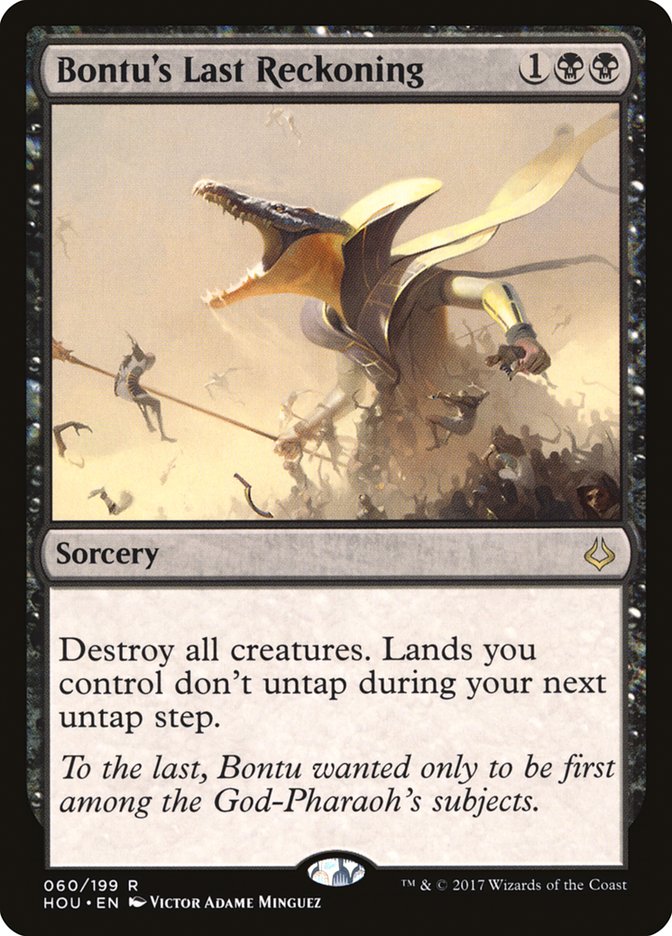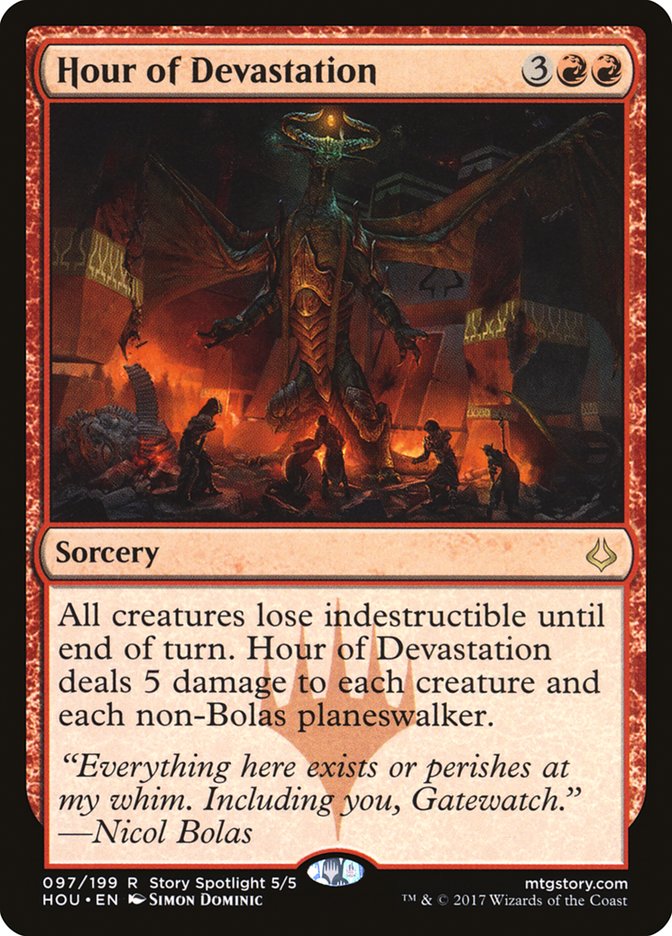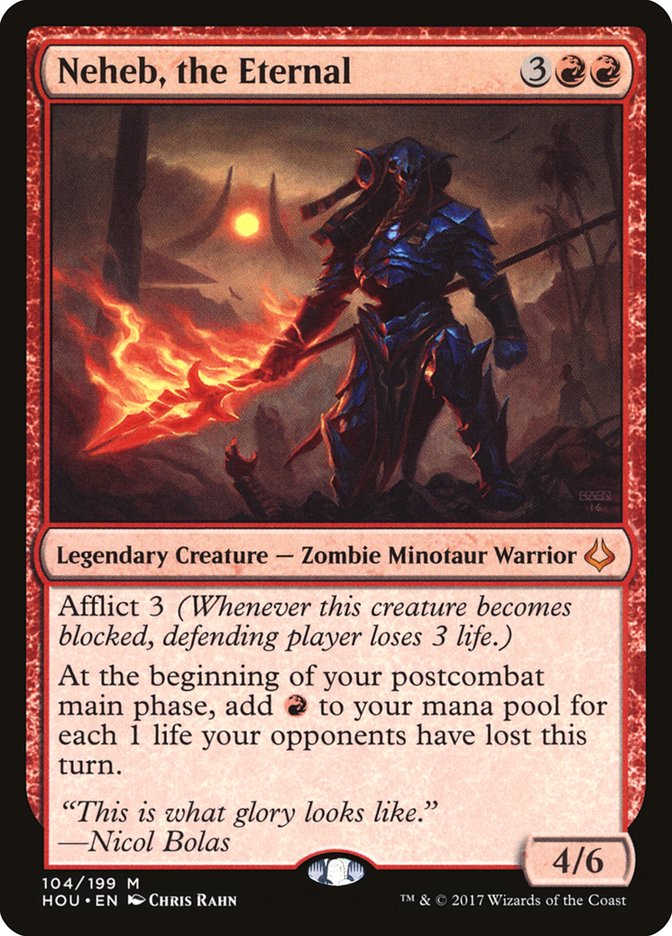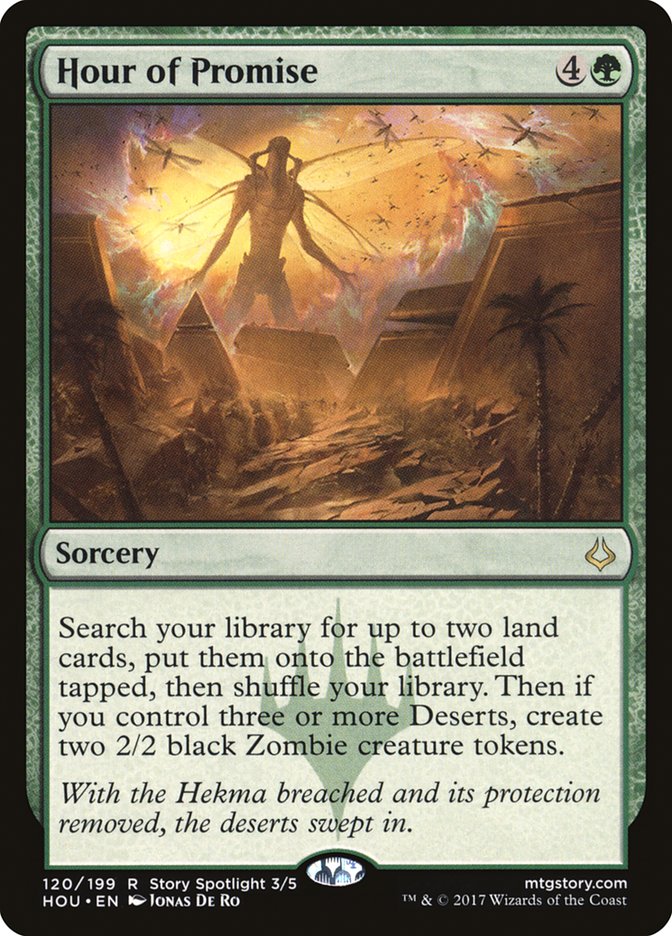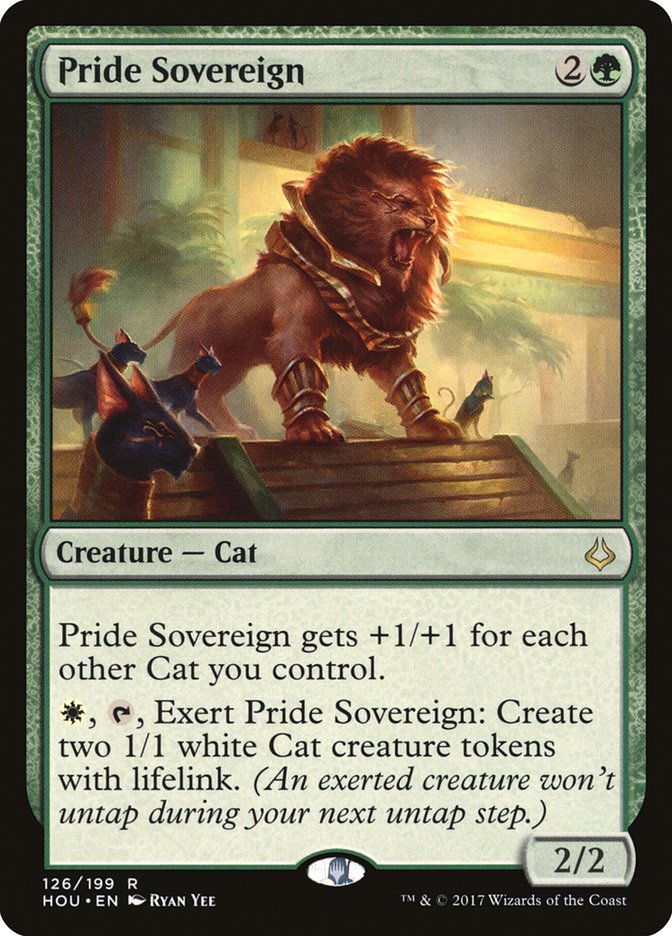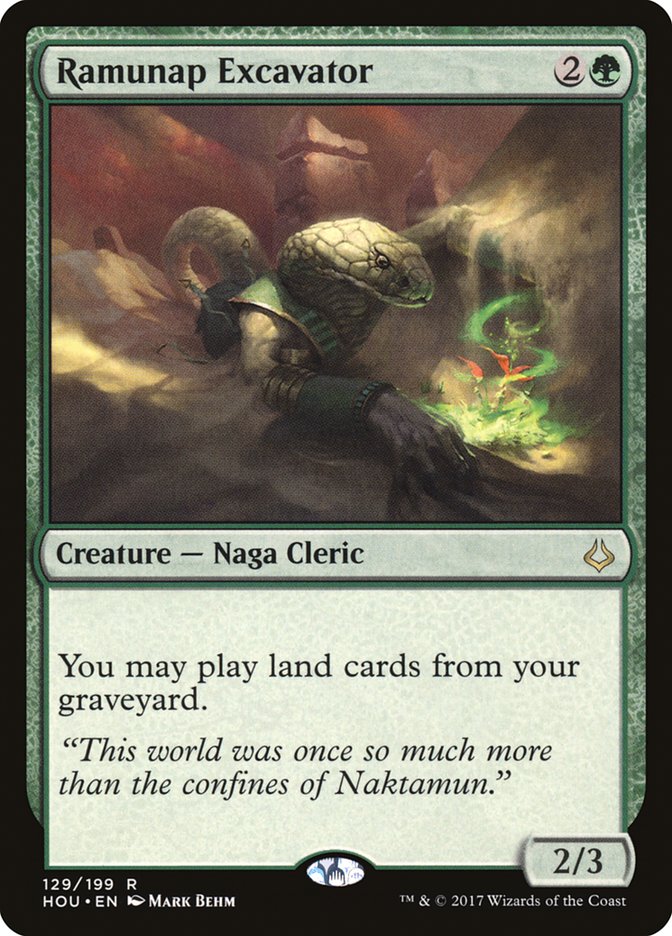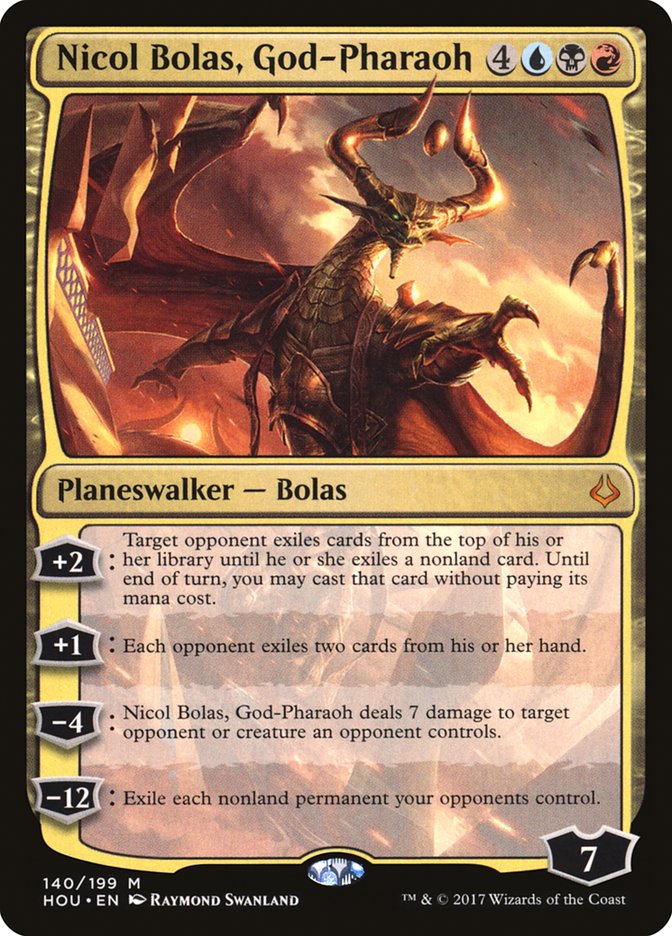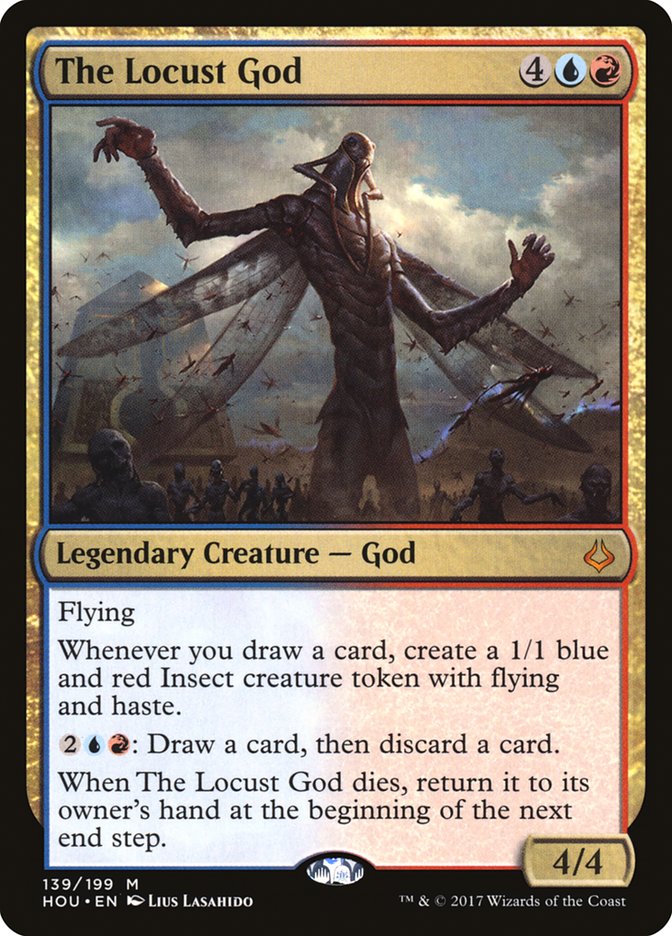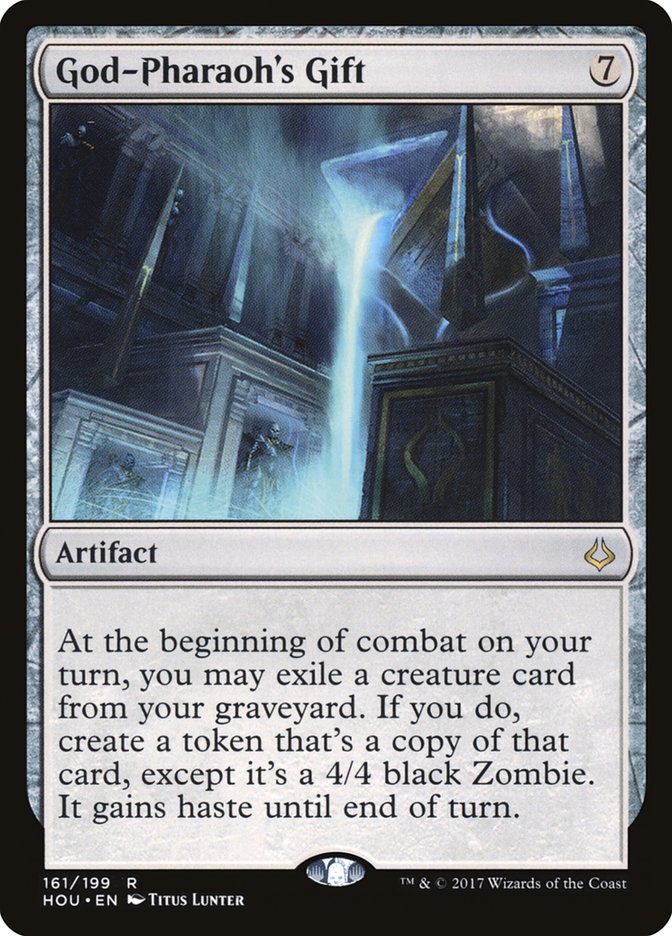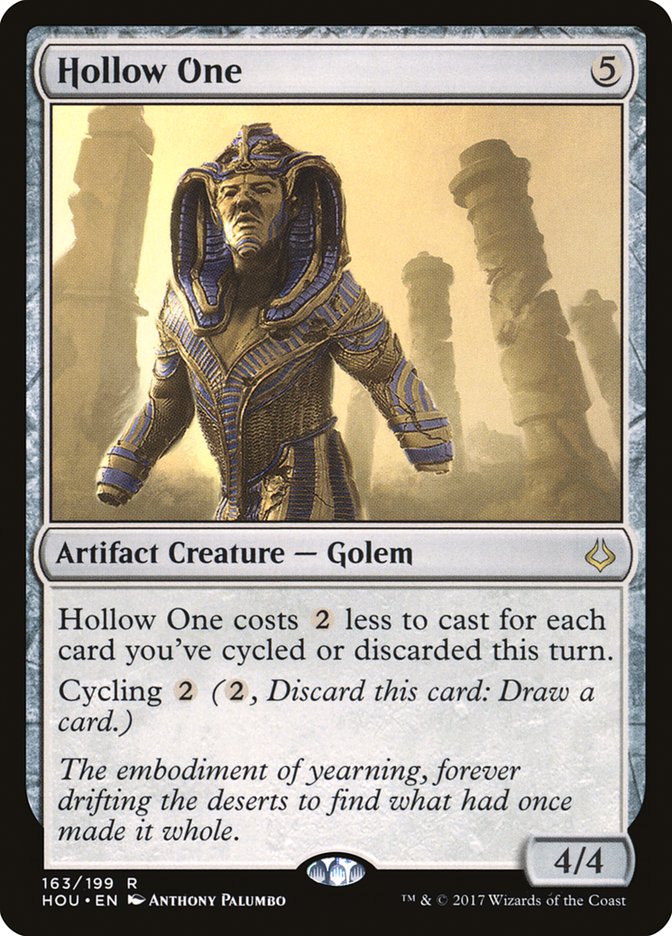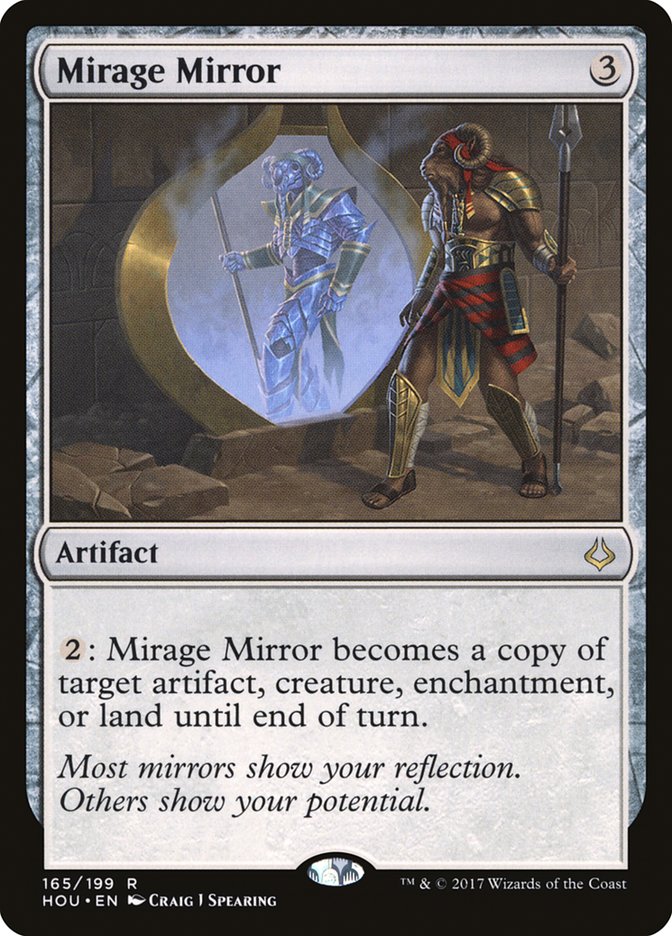The hour is nigh! Will you be the devastated or the devastator? Hour of Devastation, the flavor-rich follow-up Amonkhet, will let you find out which. Let’s look into what new weapons are available for your arsenal.
I’ll take a look at each of the colors, point out the significant cards, pick my favorite three, and then grade the color as a whole. Remember that this is a review for Commander only. There are quite a few cards in the set which will be high octane gas in other formats which might not even get mentioned here. Such is the nature of Magic and the brilliance of having different formats.
White
Angel of Condemnation: Blinky the Angel isn’t quite its distant Eldrazi Displacer cousin, but it also doesn’t have the sometimes-awkward colorless mana requirement. I’m a fan of the flexibility of being able to either blink something or Oblivion Ring it. The more exert we find ourselves with, the more I think we’ll see ways for players to untap their creatures. In an Eternal format like Commander, there are certainly plenty of ways to do that—like Umbral Mantle.
Crested Sunmare: Who would have thought about Horse tribal? There currently aren’t enough to make a viable deck from, but remember that all your Changelings are also Horses, so this might be a cool addition. Note that the end-step trigger from Crested Sunmare can’t trigger off another end-step trigger. If you want the condition to be met, you’ll have to gain life beforehand. Suture Priest comes to mind, and if folks are reluctant to put creatures onto the battlefield, you can encourage them with Forbidden Orchard. I imagine Crested Sunmare gets some play with Trostani, Selesnya’s Voice.
Dauntless Aven: Both from a Bird tribal perspective and from untapping creatures you’ve exerted, Dauntless Aven is worth a look.
Desert’s Hold: Hour of Devastation looks like a great set for flavor, and Deserts are among those tasty bits. Desert’s Hold is a straight upgrade to Arrest, since it does exactly the same thing plus potentially more.
Disposal Mummy: Repeatable graveyard removal in colors which aren’t black come at a premium. An obvious addition to some blink decks.
Djeru, With Eyes Open: Searching up a planeswalker is already good enough. Protecting it and its friends even better. A solid role-player in either a Superfriends deck or one with just a few planeswalkers.
Gideon’s Defeat: Since indestructible is a thing in Commander, exile is also a thing. There are certainly enough great white creatures floating around your environment that you’ll always have a target for Gideon’s Defeat. The “…or blocking” part lets people be a little less smug about throwing Avacyn, Angel of Hope in front of stuff.
Hour of Revelation: This might as well be called Hour of Every Commander Game Battlefield Wipe. Once again, we have an Hour of Devastation card which upgrades an existing one, this time Planar Cleansing. Being able to wipe out everything for only WWW means that you can get started on rebuilding your battlefield state right away.
Oketra’s Last Mercy: So far, I’m a little chilly on the cards which don’t let your lands untap. Obviously, you can get around that with Seedborn Muse if you’re playing green, but the cards aren’t that great in the format. This one can be solid if your life total is low and you have other ways of casting your spells or untapping your lands.
Overwhelming Splendor: Ouch for the enchanted player, who is pretty much shut down from the lion’s share of what many Commander decks do. The good news is that if your creatures have +1/+1 counters on them, the counters still make the creatures bigger. It’s a small solace. Someone like me, who generally lets creatures like Silverchase Fox deal with enchantments, might need to rethink a few plans.
Saving Grace: I have two words, and they’re Mogg Maniac.
Solemnity: Another super-ouch, especially to all those Atraxa, Praetors’ Voice players out there. Solemnity is going to be problematic, both for shutting down certain strategies and enhancing others. For example, creatures with persist will now be able to do their thing over and over. I can certainly see some sort of lock deck featuring Solemnity and Glen Elendra Archmage. I’m sure over the coming months there will be quite a few words written about this card for this format and others. In our Commander 2016 Rotisserie Draft, Shea may have to hate draft it in order to protect his Atraxa deck.
Unconventional Tactics: I’m not immediately sure that this wrecking ball in Limited will be worthwhile in Commander, but it still might be worth someone exploring.
Top 3: Angel of Condemnation, Crested Sunmare, Hour of Devastation. Overwhelming Splendor and Solemnity are rather easily arguable as better cards, but I’m not sure they make better games. The latter will certainly create game states that you’ve never before seen.
GRADE: B-. Some nice cards, but the overall density is a little low.
Blue
Champion of Wits: Pretty clearly going into a self-mill/reanimator-style deck, the challenge in the card is to see how big you can make it enter the battlefield as so that you can get into more of your deck.
Eternal of Harsh Truths: I don’t think afflict is going to have that huge an impact on Commander, but some cards with it might. This one is fine if you can make it unblockable, like with Thassa, God of the Sea.
Fraying Sanity: A fine tool for your mill deck, especially if your intention is to make a particular opponent’s graveyard extra juicy for your own enjoyment. Fraying Sanity plus Traumatize is one of those jokes that gets less funny every time someone tells it, but you know there’s that one person who is going to run it anyway.
Hour of Eternity: As I’ve mentioned on numerous occasions, I’m not a fan of exiling creatures from my graveyard because I want to cast/Regrow/reanimate them multiple times. For a deck which isn’t going to do that and maybe doesn’t want anyone else to be able to do it to them either, Hour of Eternity might just work.
Imaginary Threats: There’s quite a bit packed onto one card here. You have to time it a little better than Sleep, which does all the work for you, but since it’s an instant, you have more options. Forcing someone to attack, especially when they can’t attack you (like via Propaganda) is good, since it starts battering your other opponents. Tapping down said team (note that it’s all creatures, not just the ones which attacked) an extra turn adds to the value. We top it off by giving it cycling, meaning if it’s not situationally right for you, you can try to find something else.
Kefnet’s Last Word: You pay for the flexibility over Control Magic by not getting to untap your lands, but as mentioned, probably capable of being overcome in the format.
Nimble Obstructionist: Doubt we actually see it much on the battlefield. Like Decree of Justice, it’s a card which will live to be cycled. Blowouts will ensue. It doesn’t seem like much, but in the long run, I imagine a chance that it’s going to be one of the most-played cards from the set.
Riddleform: Maybe in janky Sphinx tribal—which after this set is certainly possible.
Strategic Planning: Definitely the tool you want to use for your Reanimator/Dredge/graveyard-matters decks.
Supreme Will: The flexibility is nice, but the payoff is a little weak.
Swarm Intelligence: Copying spells for free is dangerous. At seven mana, it’s not too dangerous, but there are hosts of cards which make Swarm Intelligence worth risking. Time magic is the obvious thing which can get out of control, but the biggest value angle will be with card draw. Once you’ve resolved Swarm Intelligence, you can spend a little less on X-spells to get greater value. You might Blue Sun’s Zenith for four instead of waiting until you have a huge pile of mana or do the same with Sphinx’s Revelation. Of course, you don’t need to copy just blue instants and sorceries. Blasphemous Act gets loads more painful. And, of course, there’s Pyromancer’s Goggles, which just makes things silly. I think plenty of folks’ suggestions for Idiotic Combo will start with “Okay, with Swarm Intelligence on the battlefield…”
Tragic Lesson: Tragic for you, since the land is going to be Bojuka Bog.
Unesh, Criosphinx Sovereign: There are already six other legendary Sphinxes. Unesh makes a fine addition to a tribal version of any of them, or as the commander in its own right. Every Sphinx you’re going to play does something cool already; getting additional cards with each of them seems like lots of winning.
Vizier of the Anointed: At this point in the review, nothing with eternalize or embalm is exciting enough to want to play Vizier of the Anointed—but let’s wait until we get through all the cards to see if something else might get the juices flowing.
Top 3: Imaginary Threats; Nimble Obstructionist; Unesh, Criosphinx Sovereign. Again, we have a card in Swarm Intelligence that’s objectively strong, but I’m not sure it’s going to make better games.
GRADE: C. Just kind of lukewarm all around.
Black
Accursed Horde: You’ll find room in your Zombie tribal deck, although most of the time, you like having Zombies in your graveyard, too.
Apocalypse Demon: I’m a fan of the days when Demons were powerful but hurt you. Apocalypse Demon is a bit of a return to those times, although we’re going to play it in decks in which we want to sacrifice creatures—like in Karador, Ghost Chieftain or, thinking about this set’s Sphinxes, some new build of Sharuum, the Hegemon.
Banewhip Punisher: Certainly a tool for your Hapatra, Vizier of Poisons deck.
Bontu’s Last Reckoning: Lots of folks are really excited about the card, but in this Eternal format, we already have enough options that we don’t need to go to this one.
Hour of Glory: Another upgrade, even knowing that you’re not likely to find another in their hand unless the one you just exiled was a copy. Amonkhet’s Final Reward costs one more mana; Gild, Oblivion Strike, and Sever the Bloodline are all sorceries (although obviously Gild and Sever the Bloodline do other stuff).
Liliana’s Defeat: The flexibility and low cost combine to make Liliana’s Defeat worth the slot in your deck. You’ll likely always have targets.
Razaketh, the Foulblooded: I’ve actually gotten questions on whether this “version of Griselbrand” is going to get banned. For one, it’s not anywhere close to Griselbrand. Two, we don’t emergency or pre-emptively ban cards. Three, it’s nowhere near ban-worthy. It seems pretty strong, though, even if the combo player isn’t likely using it to tutor up their pieces. Again, it’ll go into decks which like to sacrifice creatures for fun and/or profit; the Demonic Tutor function means that players who are so inclined might be able to end the game right away. It’s one of those cards that local play groups might want to talk about, but it’s a long way from being problematic for the format.
Ruin Rat: A new toy for Shirei, Shizo’s Caretaker decks. Maybe pops up occasionally in Karador, Ghost Chieftain builds.
Torment of Hailfire: That Bolas is pretty serious. The card will be quite nasty if the caster can generate an excess of mana, but it’s no worse than Exsanguinate in that regard (at least when it comes to killing other players). The fact that opponents simply can’t sacrifice lands can make it deadly. As is mentioned in the Hour of Devastation release notes, state-based actions aren’t checked in between iterations, so you might end up with some temporarily awkward-looking battlefield states. You’ll have to keep track of what went away in what order in case things trigger off of certain conditions.
Torment of Scarabs: Again, I’m not sure I want to give opponents free sacrifice outlets.
Torment of Venom: The fact that it’s an instant might get it some play.
Top 3: Apocalypse Demon; Razaketh, the Foulblooded; Torment of Hailfire.
GRADE: D+. Density extremely low, and the best cards aren’t all that great.
Red
Chaos Maw: Crater Hellion-lite with no echo. Perfect alongside Mark of Asylum.
Crash Through: A one-mana stalemate-breaker and a cantrip is just what the doctor ordered.
Firebrand Archer: A combo deck which casts a load of spells might kill more quickly with Firebrand Archer, especially since it damages each opponent every time.
Hazoret’s Undying Fury: Of the cards which make your lands lazy, this might be the one I like most. There’s not much like it in red.
Hour of Devastation: The set’s namesake card is representative of the whole—it doesn’t quite get all the way there. I love the idea, but you’re still going to have to perform some trickery to get what you need out of the card. To be fair, it only costs five mana and it takes out (most) planeswalkers as well. It just feels like flavor-wise, it should be able, perhaps conditionally, to deal enough damage to kill every creature in the set. That condition might be controlling a Bolas planeswalker. I suppose it’s lethal to nearly everything if you control Swarm Intelligence. It has its uses, but I’m just left wanting more.
Manticore Eternal: A creature with both power and afflict high enough to be worth considering.
Neheb, the Eternal: Okay, now we have a card that’s kind of insane. In any aggressive red deck, you’re going to set up combats which then generate enough mana for you to cast a big finisher, like Comet Storm, or even just a pile of other creatures to battle with for the next combat. Add Rakdos, Lord of Riots for double the fun. Neheb, the Eternal is truly a card limited only by your imagination.
Wildfire Eternal: You might have a little success in the early part of the game because there will always be a player who doesn’t have a blocker. Otherwise, you’ll need to have some method of making it unblockable to get the trigger.
Top 3: There’s isn’t a Top 3 for red, which isn’t the first time I’ve said that in the last few sets. Here, there’s Neheb, the Eternal, then there’s everything else. While there are a few useful things, red once again gets the short straw.
GRADE: D-. Only Neheb keeps the color from being a Commander failure.
Green
Beneath the Sands: Sometimes the late-game answer to drawing a ramp spell is to just get the land anyway. With Beneath the Sands, you draw a card—if it’s a land, you can drop it for one cheaper than the spell costs. It’s not Cultivate or Kodama’s Reach, but it has its uses.
Hope Tender: Untapping lands is going to lead to explosive plays, especially in a format in which there are a few lands which produce big piles of mana, such as Gaea’s Cradle; Nykthos, Shrine to Nyx; and Cabal Coffers.
Hour of Promise: Speaking of which, this is the card which I’m approaching with the most caution. It’s another one which folks have already emailed me about, and I see both justifiable excitement about the broken stuff you can do with it and the trepidation of how easily broken stuff can happen with it. It’s not Primeval Titan, for sure, but how many times do you need to fetch Cabal Coffers and Urborg, Tomb of Yawgmoth to go off? The saving grace is that the lands enter the battlefield tapped, so it’s at least less scary than the combination of Tempt with Discovery and at least one greedy opponent. The card already has and will continue to generate discussion about itself and some of those previously mentioned lands. Don’t read anything into my comments about the near-term fate of any specific card, but also be careful about speculating on anything.
Majestic Myriach: It’s always at least a 2/2, since it counts itself, and it’s likely to have lots of abilities. It’s not all that complicated, but there’s a lot to like about the card.
Nissa’s Defeat: The playability of Nissa’s Defeat will depend on how many green planeswalkers are in your local environment. If they’re popular, the card’s flexibility will make it worth your while.
Pride Sovereign: Cool card—except for the fact that there are no G/W legendary Cats to lead the deck.
Quarry Beetle: The dredge decks and nearly any with fetchlands will like the Quarry Beetle. The Amonkhet lands with cycling also become even more attractive.
Ramunap Excavator: Crucible of Worlds on a stick gives you another, perhaps more affordable, option to playing lands from your graveyard.
Sifter Wurm: I think I like the consistency of Pelakka Wurm a little better—plus there’s the card draw when it dies—but the library control of Sifter Wurm makes a compelling choice. No reason you can’t play both.
Uncage the Menagerie: I’ll look forward to discussion of what the perfect value of X might be. I suspect that it’s either four or five—since I wonder how many decks will have six or more six-drops (or seven or eight). If I had to choose without too much thought, I’d say four, since that’s what Solemn Simulacrum and Oracle of Mul Daya cost. Well-designed card that has a good built-in limit.
Top 3: Hour of Promise (despite my reservations), Majetic Myriarch, Uncage the Menagerie.
GRADE: B-. Like with white, a few nice things, but the density of playable-in-the-format cards is low.
Multicolor
Bloodwater Entity: Seems perfect if you’re playing Melek, Izzet Paragon.
The Locust God: Super-strong, whether it’s your commander or a role-player in a Niv-Mizzet, Dracogenious or Niv-Mizzet, the Firemind deck. Might also be an alternate win condition for the Nekusar, the Mindrazer decks. Even without the commander on the battlefield, all those wheels will create a pretty big swarm. And why couldn’t they have been locusts?
Nicol Bolas, God-Pharaoh: The block’s focus shows up as an appropriately badass card. Obviously, getting off the ultimate ability means game over. The first ability is strong enough to help you get there. The God-Pharaoh is one of those cards which can turn the table into an Archenemy scenario all by itself, so I’d say the flavor of the card is spot on.
Obelisk Spider: Once again, a great tool for your Hapatra, Vizier of Poisons deck. Remember, it sees the counters you put on your persist creatures, too.
River Hoopoe: Obviously, I’m just listing the card so that you’ll say “hoopoe.”
Samut, the Tested: The first ability is very good, especially being in the two most aggressive colors for attacking. Giving double strike to something large (Malignus, anyone?) will simply kill people. You might consider Samut’s ultimate as a fixed Tooth and Nail. Sure, it can be deadly, but it’s also hard to do.
The Scarab God: B/U Zombie decks have a new commander, and the deadly are rising. The ability to exile creatures from any graveyard keeps them in check and provides you with more Zombie fuel. It’s not going out on a limb to call this the best Zombie commander ever. Although I obviously prefer my Gods indestructible, the trigger gives you some options that you might not consider with commanders which go right to the command zone. If someone expends graveyard removal just to make you pay two more for it, then they’re not using it the more important things you have. If they don’t, you just get to recast it for the normal cost. In the running for my favorite card in the set.
The Scorpion God: How many alters of this are going to show up with The Rock’s mug on them? The Scorpion God might need a little more support than the other Gods in the set, but it’s full of value for you, because you know you’re playing it in a proliferate deck. And with Cauldron of Souls. Definitely Cauldron of Souls.
Struggle // Survive: Killing a creature so that you can cast the Survive half is all upside.
Appeal // Authority: The very low cost of both halves might get it some consideration. It’s not spectacular, but it seems eminently useful.
Leave // Chance: Leave saves your most important permanents from a big battlefield wipe—even if it’s your own. Chance lets you put what you want into the graveyard, either because you can’t use it or because that’s exactly where you want it, and then fills you back up again.
Reason // Believe: You’re probably going to cast both halves right way in order to cut down on the cost of something huge. You put it onto the battlefield instead of casting it, which does one good thing and one less good. Once you’re to the point of choosing the card, no one can counter it (they’d have to counter Believe in order to stop you). The less good thing is that you don’t then get cast triggers of off some huge things like Ulamog, the Infinite Gyre. Still, getting Ulamog onto the battlefield for six mana is pretty good beats.
Grind // Dust: I imagine that your first thought, just like mine, was “Ooh, cheap Black Sun’s Zenith.” The fact that you can avoid exiling your own is amazing. The aftermath mechanic lets them template a card in a way that they might not if it didn’t have the same restriction.
Refuse // Cooperate: Another card for You Did This to Yourself! I couldn’t be happier. And then to be able to make you do more stuff to yourself later? Love it.
Driven // Despair: Wow! I’d play Driven by itself. The discard part of Despair is okay, but the menace makes it super-good for just four total mana.
Top 3: Nicol Bolas, God-Pharaoh; Samut, the Tested; The Scarab God.
GRADE: A+. More than three to go into the top, and nearly everything is at least playable. This is what I had been hoping for all along. Guess they saved the best stuff for multicolor.
Artifact and Land
Abandoned Sarcophagus: If you’re like me, you’ll have to read the card once or twice extra to make sure you understand how it works. It basically keeps you from milling stuff into your graveyard to be able to cast it later.
Crook of Condemnation: Different enough from Relic of Progenitus that you’ll need to think about which one you play if you only have one slot. I’m a fan of Crook of Condemnation because the first ability targets a card instead of letting the owner choose.
God-Pharaoh’s Gift: Seems a little expensive (unless you go get it with Gate to the Afterlife). Once again, I’m not a fan of exiling creatures from my own graveyard, but in a deck that’s not going to reuse them, this becomes a cheap (once it’s on the battlefield) way of getting an extra attacker which might also do something cool.
Graven Abomination: The only concern is obviously keeping it alive; otherwise, Graven Abomination might do some heavy lifting for you.
Hollow One: In other formats, this might be something. In this one, even if you paid zero to cast it, it’s still just a vanilla 4/4.
Mirage Mirror: Warning! Shenanigans will ensue, as multiple activations of Mirage Mirror stacked on top of each other will allow you to activate the abilities of whatever you’re copying in between. Permanents which look back on what happened during the turn will be especially good to be the last thing copied. For example, activate Mirage Mirror copying Khabal Ghoul and then respond by targeting Greater Good. Sacrifice some creatures. At end of turn, get counters—which will stay on Mirage Mirror even when it’s not a creature. Next turn, when it becomes a creature—maybe even one on which counters matter, like Deathbringer Thoctar—you’ll be ready for action. It’s easy to predict this one as the card in the set which generates the most rules questions.
Sunset Pyramid: Seems decent in a proliferate deck.
Traveler’s Amulet: It’s no Wayfarer’s Bauble, but it’ll do.
Crypt of the Eternals: Some nice mana fixing that doesn’t enter the battlefield tapped in Grixis, which can generally use all the help in that regard it can get.
Dunes of the Dead: Combo with Army Ants? Constant Mists? Crop Rotation? Obviously, its uses are multiplied if it’s in a deck with Ramunap Excavator or Crucible of Worlds. Obviously, The Gitrog Monster finds it quite delicious.
Endless Sands: Especially if you play in an environment with not a lot of targeted land destruction, you can start saving your creatures from either unfavorable combats or mass removal—only to bring them back in the hour of your greatest need. I’m reasonably sure that someone will pick up this card in our Commander 2016 Rotisserie Draft League, since there’s nearly no land destruction at all.
Scavenger Grounds: Since it’s a Desert, you can sacrifice it to pay for itself. It takes land-based graveyard hate into colors other than black, but obviously also hits your own.
Survivors’ Encampment: A nice way to get King Macar, the Gold-Cursed (or other creatures with inspired) tapped without having to attack.
Top 3: Not really enough cards in the category to choose a Top 3 from. Mirage Mirror stands out in the artifacts, as does Endless Sands in the lands.
Grade: B. Again, given the small numbers, it’s a somewhat tough to grade. There are some useful choices. Making Deserts a thing is cool, and the full-art lands are even more breathtaking than those from Amonkhet.
***
My overall grade for Hour of Devastation works out to about a C+. There are several cards you’ll absolutely want to snap up for your Commander decks, as well as some which inspire new decks. The set has a few other role-players, but for the most part it’s one of the least-dense sets for Commander in quite a while. That said, it looks insanely good to draft. The setting, worldbuilding, and flavor are all amazing, making Hour of Devastation a just follow-up to Amonkhet in that regard.
Our regular features Idiotic Combo and Deck Without Comment will return after Hour of Devastation release season.
Check out our comprehensive Deck List Database for lists of all my decks:
SIGNATURE DECKS
Purple Hippos and Maro Sorcerers; Kresh Into the Red Zone; Halloween with Karador; Dreaming of Intet; You Did This to Yourself;
THE CHROMATIC PROJECT
Mono-Color
Heliod, God of Enchantments; Thassa, God of Merfolk; Erebos and the Halls Of The Dead; Forge of Purphoros; Nylea of the Woodland Realm; Karn Evil No. 9
Guilds
Lavinia Blinks; Obzedat, Ghost Killer; Aurelia Goes to War; Trostani and Her Angels; Lazav, Shapeshifting Mastermind; Zegana and a Dice Bag; Rakdos Reimagined; Glissa, Glissa; Ruric Thar and His Beastly Fight Club; Gisa and Geralf Together Forever;
Shards and Wedges
Adun’s Toolbox; Animar’s Swarm; Karrthus, Who Rains Fire From The Sky; Demons of Kaalia; Merieke’s Esper Dragons; Nath of the Value Leaf; Rith’s Tokens; The Mill-Meoplasm; The Altar of Thraximundar; The Threat of Yasova; You Take the Crown, I’ll Take Leovold; Zombies of Tresserhorn
Four-Color
Yidris: Money for Nothing, Cards for Free; Saskia Unyielding; Breya Reshaped
Five-Color
Partners
THE DO-OVER PROJECT
Animar Do-Over; Glissa Do-Over; Karador Do-Over; Karador Version 3; Karrthus Do-Over; Steam-Powered Merieke Do-Over; Mimeoplasm Do-Over; Phelddagrif Do-Over; Rith Do-Over; Ruhan Do-Over
If you’d like to follow the adventures of my Monday Night RPG group (in a campaign that’s been alive since 1987) which is just beginning the saga The Lost Cities of Nevinor, ask for an invitation to the Facebook group “Sheldon Menery’s Monday Night Gamers.”


